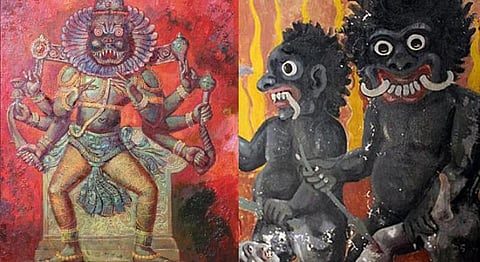
- HOMEGROWN WORLD
- #HGCREATORS
- #HGEXPLORE
- #HGVOICES
- #HGSHOP
- CAREERS
- ABOUT US
- CONTACT US

It’s the stuff you see in movies – sharp fang-like teeth with blood dripping down the edge of their lips, a white-washed face with high hair and eyes that can only be described as marbles reflecting a beam of light. If you haven’t been able to catch on, we’re talking about vampires.
Now more popular as mystical creatures, interesting enough to base several movies and TV series on, vampires have had a dynamic rise to popularity. The vampire myth isn’t exactly what it used to be, as we doubt any of them could ever match up to Edward Cullen of Twilight (2008) or Damon Salvatore of The Vampire Diaries (2009).
A lesser-known fact, however, is that India has several links to the modern vampire, owing to its vast mythology and folklore. They may not be the shirt-and-cape-clad beings that come up in your mind, but here are a few instances of Indian creatures that might just be more vampire-like than the vampire itself.
Vetala
Most of what Indians know of Vetala comes from the stories of Vikram and Betaal of Betaal Pachisi written in the 11th century. Vetala, however, holds a much deeper and disturbing history. Per mythology, Vetala is considered to be the one that takes possession of corpses in cemeteries and haunts the neighbouring villages and its people. Hence, technically, they never really die, much like any other vampire.
Vetala was believed to cause all kinds of horrific incidents such as the murder of children and miscarriages. Apparently, they are stuck in what is called ‘the twilight zone’ which lies between life and after-life. Neither entirely dead nor entirely alive, Vetala definitely holds resemblance to the vampires of today.
Rakshasa
Considered one of the scariest beings to have existed in Hindu mythology, the Rakshasa was believed to be a demon of sorts. They could shapeshift into a being of their choice ranging from animals to monsters, and Rakshasi (female Rakshasa) could even turn themselves into attractive women to lure men.
Much like vampires, they are dispelled by direct sunlight or light and thrive in the darkness. They were believed to wander around cemeteries at night and cause evil activities to take place. Agni (fire) was used to do away with the darkness, so as to keep away the Rakshasa too. The most powerful Rakshasa to have ever lived was Ravana, the 10-headed creature from the Ramayana.
Peymakilir & Pey
Fulfilling the all-important blood-thirsty criteria of vampires, Peymakilir and her male counterpart, Pey would viciously feast on human bodies. While Pey was known for downing all the blood available in each body, Peymakilir was more popular for performing a ritualistic dance on the corpses.
As part of the Tamil folklore, Peymakilir and Pey were vampires of battlegrounds and wars. For this reason, they were also sometimes considered angels of mercy as they would end the misery of soldiers that were close to death and were suffering from agonising pain.
Pishacha
With red, bulging eyes such as those of modern vampires, Pishachas are creatures from Hindu mythology that are nocturnal and hunt cremation grounds during the nights. They are also believed to have the power of shapeshifting and also becoming invisible. Apparently, they could also possess humans and drive them insane.
With sunlight as an opposing force, the Pishacha is close to your standard vampire in many ways – darkness-loving, blood-hungry and carrying the overall appearance of a vampire doppelganger.
Far from what they began as, vampires seem to have maintained their spooky charm through the years. Who knew, that India had a part to play in this, too?
If you enjoyed reading this, we suggest you also read:
